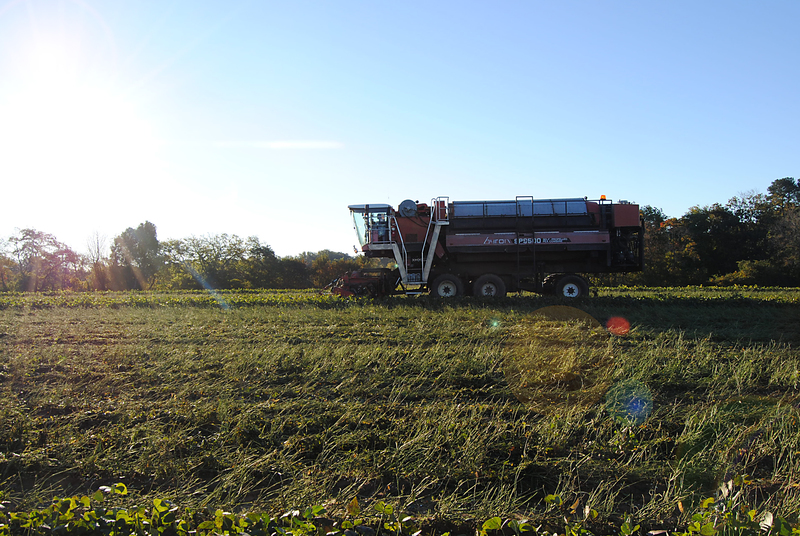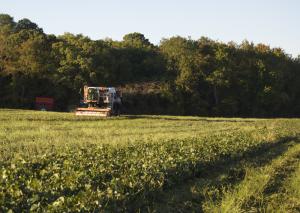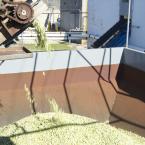Lima beans reign supreme in Sussex County, especially after they survived this year's drought.
While corn and soybeans withered in dry fields, limas reflowered under late August rains and cooler temperatures across the region. This combination meant a harvest that was three weeks late, but one that produced the best crop in three years.
With a boost from a $1.5 million federal grant aimed at improving lima bean research matched by a state Delaware farmers could become the top lima bean producers in the nation. For years, Delaware production has fallen just short of California output.
Brad Ritter, 50, a third-generation farmer who has been farming most of his life in the Lewes and Harbeson area, harvested 15 acres near Belltown Oct. 15 with the help of J.G Townsend processing company.
Ritter's yield was better this year than last year, but it was not record-breaking. He pulled 3,400 pounds of limas per acre; 4,000 pounds per acre would have been a record-breaker, he said.
"I'm happy with it," Ritter said. "It was better than anticipated."
While persistent drougt withered other Delaware crops, lima beans don't need much water to thrive. Ritter's fields at the Graves farm outside Lewes are not irrigated, leaving the farmer to depend on Mother Nature's good graces.
"For the last couple of years, we have been struggling with high temperatures," Ritter said. "The heat hurts the lima beans more than dry weather does, so it's been a tough few years."
This year, late August rains allowed the lima plants to reflower and produce new bean pods, leaving Ritter and other lima bean growers with a bumper crop.
“Limas are important to Delaware,” said Ritter. “My family has been growing them as long as I can remember."
The Ritter family started farming in the Cape Region in the early 1900s. Brad followed his grandfather and father into the business, and with the help of his family, he was able to procure his own land.
“My uncle was kind enough to split up the family farm and give me some land,” Ritter said. Today, he tills about 1,600 acres with more than 250 acres planted with baby lima beans.
The Ritter family has always worked with Townsend processors. In the mid-1900s, Ritter’s grandfather worked with Townsends to build the first machine on wheels to harvest limas. Before then, the lima beans were harvested by hand.
Processing the beans
"We work with six local growers and harvest their lima beans for them,” said Paul Townsend, third-generation operator of J.G. Townsend’s processing plant in Georgetown. “We are in the food preservation business.”
Townsend’s has been operating in the center of Georgetown since 1911. On any give day in season, residents can see a shower of shucked lima beans pouring onto the first of a system of conveyor belts that concludes in the company's monstrous freezer.
“Here we flash-freeze our products,” said Townsend. “We found flash-freezing was better than other methods to preserve fruit and vegetables."
The Townsend family used to farm, but now the business relies on other farmers for beans to stock the nation’s freezers.
“The lima bean harvest has been good this year,” Townsend said. “The wet August helped because the rain came just when farmers needed it. This year has had some of the highest yields we’ve seen recently.”
Townsend said federal funding for research could help farmers identify the best varieties of beans to plant to maximize yield. Ritter agreed. He said he is always excited to see new variety trials at University of Delaware.
Research gains federal funding
“Sussex is lima bean heaven,” said Tom Evans, professor of plant and soil sciences at University of Delaware, where scientists have been researching lima beans for decades.
The sandy soils and lower temperatures in the early fall make limas a hardy crop for Delaware farmers, he said.
In partnership with local growers, buyers and field researchers, UD applied for a U.S. Department of Agriculture small-crop grant for more than $1.5 million. To receive the full grant, the university and its collaborators had to provide a 100-percent match.
Besides looking at the best varieties to grow in Delaware, researchers will also look at disease, a common problem for lima bean farmers in Sussex.
Lima bean pod rot and downy mildew, are the most common enemies of lima beans. Researchers hope to breed a variety that is resistant to both diseases.
Emmalea Ernest, a University of Delaware researcher, tests varieties of limas to determine which thrives in Sussex. She then uses that genetic information to breed new lima varieties.
"We hope to be able to correlate some of the genetic information with useful traits I am trying to select for in my breeding program," said Ernest, who has been researching lima beans for years. "This will help me to know how the traits are inherited and hopefully select for them more easily."
"I will also be working with some other collaborators on the project to genetically characterize a range of diverse lima bean varieties and begin developing lines to use for genetic studies," Ernest said.
In Delaware, nearly 14,000 acres are planted in baby lima beans. In Sussex, about 30 farmers are growing limas for processing.
The Delaware Department of Agriculture under Secretary Ed Kee, a long-time lima bean lover, provided $75,000 in state funding. The remaining funds came from processing companies interested in improving Delaware harvests and from the growers themselves and included in-kind donations of employee time, research facilities, equipment and resources, said Evans.
The grant will allow UD researchers to collaborate with University of Maryland and Delaware State University researchers. It will also provide funding for up to 10 faculty and extension professionals and eight new graduate students, who will be working on the project.
“In the next 10 years, this research could make a real difference in plant health,” Evans said. “It’s a step-up in the amount of resources and the number of people we have to get this research done more quickly. It would have taken a long time without this grant funding.”
An advisory board will check results and progress of the research annually.
“We have been trying to get this together for almost four years and finally convinced the USDA that it is an important project,” said Evans.
































































